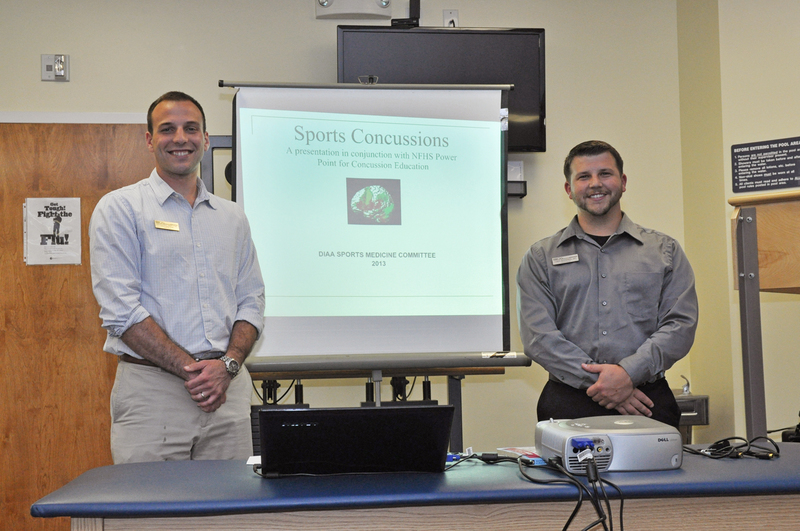Getting ahead of serious brain injuries
This week teens up and down Delaware will be kicking off the fall high school sports season. Over the next three months many athletes will sustain injuries, some minor, others more serious. And some will sustain an injury that may have a long-lasting impact on their life – a concussion.
Injuries to many high-profile professional athletes has thrust the concussion discussion into the national spotlight. Concerns over concussions and player safety have trickled down from professional and college sports to high school and youth sports, with many lawmakers stepping in to ensure the safety of all athletes.
In an attempt to better inform Cape Region athletes, coaches and parents about concussions, Southern Delaware Physical Therapy recently hosted an educational forum focusing on recognition, recovery and consequences of the injury.
Chris Massimini, clinical director for the company's Milford branch, defines a concussion as a traumatic brain injury.
|
By the numbers • Estimated between 1.6 million and 3.8 million sports-related concussions each year |
“It doesn't necessarily affect the structure of the brain where you can see it on a radiograph or CT scan or anything like that,” he said. “But it affects function; how a person feels, sleeps and the emotions that a person has.”
While Delaware is above the national average in concussion rate, Steve Peet, clinical director at the company's Rehoboth office, said it's likely the state is more focused on concussions.
“Everybody kind of thinks concussions are on the rise, but I would disagree with that statement, saying we're just getting better at recognizing them,” he said. “I think concussions have always been happening. If you talk to people who've been playing sports for years, they always had their bell rung or blacked out and woke up in the showers. That's pretty scary stuff.”
After sustaining a concussion, he said, it is important for an athlete to have an appropriate rest period. He said Delaware lawmakers have recognized the importance of an athlete's health and safety and passed legislation protecting players.
“Even if there is a suspected concussion, legislation in Delaware says you can't go back to play unless you've gone through six days minimum rest,” he said.
During that period, it's important to get plenty of rest and avoid activities that are physically demanding or require a lot of concentration.
If an athlete has a concussion or is suspected to have sustained a concussion, they must be lifted from the game immediately. As per DIAA regulations, the athlete is not allowed to return to play until they are cleared by a healthcare professional – medical doctor, physician's assistant, nurse practitioner, school nurse or athletic trainer. Written clearance must come from a medical doctor or doctor of orthopedic medicine only.
This regulation often causes zealous athletes and parents to shop doctors, meaning they find a doctor who is willing to clear the athlete to play earlier than other medical professionals.
“That's really missing the whole point of what we're trying to get across to people,” Massimini said. “It's difficult with an athlete because they just want to go back and play and get back into their sport. But it's really important to recognize this.”
A common misconception is that a concussion is linked to only football, Massimini said, but research has found that concussions are common in all sports. Football does have the highest concussion rate, but ice hockey, boys' and girls' lacrosse, girls' soccer and field hockey each have a significant amount of concussions as well, he said.
Returning to the playing field prematurely could have dire consequences, Massimini said. Repeated concussions could lead to chronic traumatic encephalopathy, a progressive degenerative disease that could cause depression, anxiety and other behavioral issues. Currently, CTE can only be diagnosed postmortem, but scientists are working to learn more about the disease. A brain bank was established at Boston University in 2008, which is dedicated to studying trauma on the brain and nervous system. Among the goals of the bank is to establish a diagnostic test for CTE.
The University of Delaware is focusing more on the safety of the athletes. A team of researchers at the university are developing a soft body armor with shear thickening fluid called liquid armor that can be applied to sports equipment. Norman Wagner, professor of chemical engineering, told the university's website, “Concussions are serious health issues. Shear thickening fluid has the potential to give a bit and absorb the shock waves so they don't damage the brain."
Peet said many high schools are beginning to establish baseline testing that will better identify concussions.
“The DIAA is starting to mandate preseason screening; pre-participation evaluations where they get a baseline to determine if this person is really having balance issues or if they have always been unbalanced,” he said.
The DIAA is also doing a much better job at educating, Peet said. On its website, DIAA links to a free course called Concussions in Sports offered by the National Federation of State High School Associations. Beginning last year, coaches are required to complete the course once every two years. NFHS recently announced that 1 million people have taken the course since its inception in May 2010.
Southern Delaware Physical Therapy has office located in Lewes, Rehoboth Beach, Long Neck, Georgetown, Milford and Smyrna. For more information about SDPT, go to www.southerndelawarept.com.
Nick Roth is the news editor. He has been with the Cape Gazette since 2012, previously covering town beats in Milton and Lewes. In addition to serving on the editorial board and handling page layout, Nick is responsible for the weekly Delaware History in Photographs feature and enjoys writing stories about the Cape Region’s history. Prior to the Cape Gazette, Nick worked for the Delmarva Media Group, including the Delaware Wave, Delaware Coast Press and Salisbury Daily Times. He also contributed to The News Journal. Originally from Boyertown, Pa., Nick attended Shippensburg University in central Pennsylvania, graduating in 2007 with a bachelor’s degree in journalism. He’s won several MDDC awards during his career for both writing and photography. In his free time, he enjoys golfing, going to the beach with his family and cheering for Philadelphia sports teams.



















































